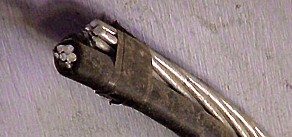

|
RESISTANCE |
 |
What is Resistance ?
Resistance is a measure of how easy
or hard it is for electric current to move through a material.
|

|
Electrical currents studied on this
web site move mostly through wires. But wires do not all have
the same resistance. The resistance depends on four things:
- the length of the wire
- the thickness of the wire
- the material the wire is made of
- the temperature of the wire
WIRE LENGTH: The longer a wire
is , the greater its resistance. The wire has greater resistance
when you make it longer. A long extension cord used to plug in
a circular saw will allow less electricity to go through the wire.
In this case, there may not be enough power to actually cut through
a piece of lumber.
WIRE THICKNESS: The thinner
a wire is, the greater its resistance. Transmission lines (power
lines) along the road are very thick. Thin wires have too much
resistance to carry large amounts of current. The thick cables
have low resistance.Large electric currents can move through them
easily.
WIRE MATERIAL: Wires can be
made of different materials. Some materials are better conductors
than others. Copper and aluminum are good conductors, and both
have low resistance. Wires made of copper or aluminum are used
to carry electric current across long distances. Nichrome and
tungsten are conductors, but with a higher resistance than copper
and aluminum. When a large current goes through the wire, the
wire gets hot. Nichome wires are used in toasters and electric
heaters. Tungsten wires are used in light bulbs. When you switch
on a light bulb, the tungsten gets so hot that it glows.
WIRE TEMPERATURE: When a wire
is cooled, its resistance gets lower. Some materials lose all
their resistance at very low temperatures. These materials are
called superconductors. Mercury is a good conductor at ordinary
temperatures and becomes a superconductor at 270 degrees below
Celsius.
 Ohms Ohms |
Resistance is measured in ohms. The
ohm is a unit of resistance. A 60 watt light bulb has a resistance
of about 200 ohms. The ohm is named after the German scientist
George Ohm.
OHM'S LAW
George Ohm found that the electrical
current in a circuit is effected by the EMF ( Electromotive Force)
and the resistance. He described the effect by a scientific rule
or law. Ohm's law says that the electric current in a circuit
is equal to the EMF divided by the resistance.
Electricians use Ohm's Law in order to tell how much load they
want to use.




